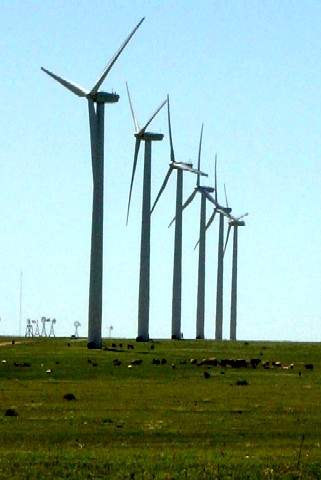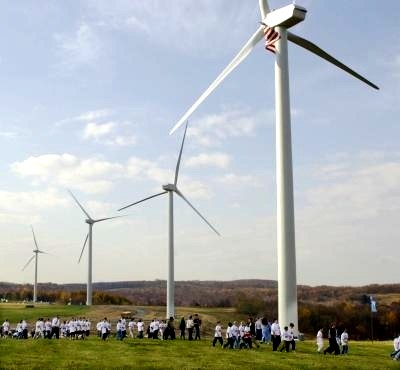Navigation
U.S. Wind Industry To Install Over 3,000 Megawatts Of Wind Power In 2007 According To Its First Quarter Market Report
The U.S. wind energy industry is on track to install over 3,000 megawatts (MW) of wind power generating capacity nationwide in 2007, with Texas likely to account for about two thirds of the new installations, the American Wind Energy Association (AWEA) said on May 10th, 2007, in its first quarter market report.
The U.S. wind energy industry is on track to install over 3,000 megawatts (MW) of wind power generating capacity nationwide in 2007, with Texas likely to account for about two thirds of the new installations, the American Wind Energy Association (AWEA) said on May 10th, 2007, in its first quarter market report.
 |
| Tthe 165-MW Colorado Green Wind Farm, Pr owers County, Colorado Photo: American Wind Energy Association |
Over 100 MW have newly come online in the U.S. so far this year, and over 1,000 more are under construction in Texas alone, according to AWEA. One megawatt of wind power produces enough electricity on average to serve 250 to 300 homes.
“Clean, cost-effective, inexhaustible, and readily available, wind power is an essential element of the solution to both climate change and America’s increasing demand for electricity,” said AWEA executive director Randall Swisher. “Texas recognized this business opportunity and successfully spurred wind power development with a Renewables Portfolio Standard (RPS) and other forward-looking policies.”
“The moment has come for the U.S. government to build on the example set by Texas and many other states, and enact a national RPS as part of any energy legislation it considers this year,” added Swisher.
Fifty U.S. Senators recently called for a “strong” national RPS and it is likely that the U.S. Congress will consider RPS legislation this summer. A Renewables Portfolio Standard uses market mechanisms to ensure that a growing percentage of electricity is produced from renewable sources.
”Already one of our nation’s top agricultural producers, Texas is now reaping the benefits of being a top wind producer,” said Ned Meister, director of Commodity and Regulatory Activities for the Texas Farm Bureau. “Texas’ RPS is fueling new economic and environmental benefits for Texas farmers and ranchers.”
 |
| Somerset Wind Farm, Somerset, Pennsylvania Each turbine has a generating capacity of 1.5-megawatts and generates on average enough electricity to serve the equivalent of 400 homes or more. Photo: American Wind Energy Association |
Wind farms revitalize the economy of rural communities by providing steady income to farmers, ranchers, and other landowners. Each wind turbine contributes $3,000 to $5,000 per year or more in farm income, while 95%-98% of the farm’s land remains free for crops or grazing.
As Governor of Texas, George Bush signed the state’s RPS into law in 1999. Texas is today the state with the largest amount of wind power in operation, providing income to rural communities, new business and jobs, as well as clean, renewable energy for its economy.
A report by the Electric Reliability Council of Texas (ERCOT) suggests that the 2,000 MW of new wind power anticipated this year would avoid over 3 million tons of CO2, annually, at a rate of about 0.48 tons of CO2 per MWh of wind -- reducing the carbon footprint of every man, woman and child in Texas by more than 250 pounds per year.
Twenty-two states now have an RPS, and, given the economic success of the policy and the urgency of addressing global warming, several have recently moved to strengthen their requirements. In the past few months alone, New Mexico and Colorado both increased their renewable energy requirement to 20% by 2020, and Minnesota adopted an RPS of 25% by 2025.
The first hundred megawatts installed this year were completed in Oklahoma (60 MW), Maine (33 MW), Texas (10 MW), and Hawaii (21 MW). Cumulative wind power generating capacity in the U.S. now stands at 11,699 MW. This capacity will generate an estimated 31 billion kilowatt-hours this year, enough to serve the equivalent of nearly 3 million average households.
Projects announced to be under construction in Texas include:
Project name: | Project size: | Project developer |
Sweetwater, phase IV | 240.8 MW | Babcock & Brown |
Buffalo Gap, phase II | 232.5 MW | AES |
Lone Star | 200 MW | Horizon, RES |
Wildorado | 160 MW | Cielo/Mission |
Camp Springs | 130.5 MW | Invenergy |
Sand Bluff | 90 MW | Airtricity |
JD Wind IV | 80 MW | John Deere |
|
|
|
For more information see AWEA’s project map at www.awea.org/projects.
AWEA, formed in 1974, is the national trade association of the U.S. wind energy industry. The association's membership includes turbine manufacturers, wind project developers, utilities, academicians, and interested individuals.
More information on wind energy is available at the AWEA web site: www.awea.org.
For more information see AWEA’s project map at www.awea.org/projects.
AWEA, formed in 1974, is the national trade association of the U.S. wind energy industry. The association's membership includes turbine manufacturers, wind project developers, utilities, academicians, and interested individuals.
More information on wind energy is available at the AWEA web site: www.awea.org.
Videos available:
Harnessing the Wind
Requires Flash Player: download the player here
Wind Farm Changes Energy Landscape
For AWEA events see www.awea.org/events
Contacts at AWEA:
Kathy Belyeu
(1)-(202) 383-2520
Christine Real de Azua
(1)- (202) 383-2508
Search
Latest articles
Agriculture
- World Water Week: Healthy ecosystems essential to human health: from coronavirus to malnutrition Online session Wednesday 24 August 17:00-18:20
- World Water Week: Healthy ecosystems essential to human health: from coronavirus to malnutrition Online session Wednesday 24 August 17:00-18:20
Air Pollution
- "Water and Sanitation-Related Diseases and the Changing Environment: Challenges, Interventions, and Preventive Measures" Volume 2 Is Now Available
- Global Innovation Exchange Co-Created by Horizon International, USAID, Bill and Melinda Gates Foundation and Others
Biodiversity
- It is time for international mobilization against climate change
- World Water Week: Healthy ecosystems essential to human health: from coronavirus to malnutrition Online session Wednesday 24 August 17:00-18:20
Desertification
- World Water Week: Healthy ecosystems essential to human health: from coronavirus to malnutrition Online session Wednesday 24 August 17:00-18:20
- UN Food Systems Summit Receives Over 1,200 Ideas to Help Meet Sustainable Development Goals
Endangered Species
- Mangrove Action Project Collaborates to Restore and Preserve Mangrove Ecosystems
- Coral Research in Palau offers a “Glimmer of Hope”
Energy
- Global Innovation Exchange Co-Created by Horizon International, USAID, Bill and Melinda Gates Foundation and Others
- Wildlife Preservation in Southeast Nova Scotia
Exhibits
- Global Innovation Exchange Co-Created by Horizon International, USAID, Bill and Melinda Gates Foundation and Others
- Coral Reefs
Forests
- NASA Satellites Reveal Major Shifts in Global Freshwater Updated June 2020
- Global Innovation Exchange Co-Created by Horizon International, USAID, Bill and Melinda Gates Foundation and Others
Global Climate Change
- It is time for international mobilization against climate change
- It is time for international mobilization against climate change
Global Health
- World Water Week: Healthy ecosystems essential to human health: from coronavirus to malnutrition Online session Wednesday 24 August 17:00-18:20
- More than 400 schoolgirls, family and teachers rescued from Afghanistan by small coalition
Industry
- "Water and Sanitation-Related Diseases and the Changing Environment: Challenges, Interventions, and Preventive Measures" Volume 2 Is Now Available
- Global Innovation Exchange Co-Created by Horizon International, USAID, Bill and Melinda Gates Foundation and Others
Natural Disaster Relief
- STOP ATTACKS ON HEALTH CARE IN UKRAINE
- Global Innovation Exchange Co-Created by Horizon International, USAID, Bill and Melinda Gates Foundation and Others
News and Special Reports
- World Water Week: Healthy ecosystems essential to human health: from coronavirus to malnutrition Online session Wednesday 24 August 17:00-18:20
- STOP ATTACKS ON HEALTH CARE IN UKRAINE
Oceans, Coral Reefs
- World Water Week: Healthy ecosystems essential to human health: from coronavirus to malnutrition Online session Wednesday 24 August 17:00-18:20
- Mangrove Action Project Collaborates to Restore and Preserve Mangrove Ecosystems
Pollution
- Zakaria Ouedraogo of Burkina Faso Produces Film “Nzoue Fiyen: Water Not Drinkable”
- "Water and Sanitation-Related Diseases and the Changing Environment: Challenges, Interventions, and Preventive Measures" Volume 2 Is Now Available
Population
- "Water and Sanitation-Related Diseases and the Changing Environment: Challenges, Interventions, and Preventive Measures" Volume 2 Is Now Available
- "Water and Sanitation-Related Diseases and the Changing Environment: Challenges, Interventions, and Preventive Measures" Volume 2 Is Now Available
Public Health
- Honouring the visionary behind India’s sanitation revolution
- Honouring the visionary behind India’s sanitation revolution
Rivers
- World Water Week: Healthy ecosystems essential to human health: from coronavirus to malnutrition Online session Wednesday 24 August 17:00-18:20
- Mangrove Action Project Collaborates to Restore and Preserve Mangrove Ecosystems
Sanitation
- Honouring the visionary behind India’s sanitation revolution
- Honouring the visionary behind India’s sanitation revolution
Toxic Chemicals
- "Water and Sanitation-Related Diseases and the Changing Environment: Challenges, Interventions, and Preventive Measures" Volume 2 Is Now Available
- Actions to Prevent Polluted Drinking Water in the United States
Transportation
- "Water and Sanitation-Related Diseases and the Changing Environment: Challenges, Interventions, and Preventive Measures" Volume 2 Is Now Available
- Urbanization Provides Opportunities for Transition to a Green Economy, Says New Report
Waste Management
- Honouring the visionary behind India’s sanitation revolution
- Honouring the visionary behind India’s sanitation revolution
Water
- Honouring the visionary behind India’s sanitation revolution
- Honouring the visionary behind India’s sanitation revolution
Water and Sanitation
- Honouring the visionary behind India’s sanitation revolution
- Honouring the visionary behind India’s sanitation revolution

